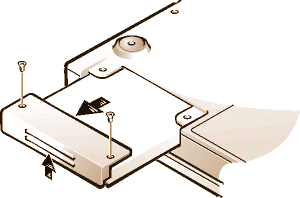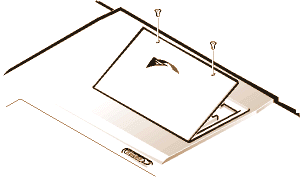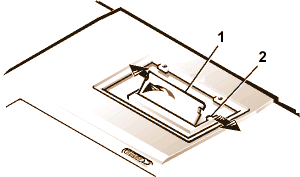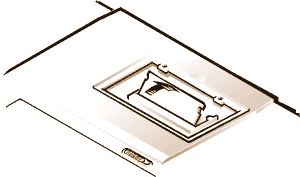| Replacing a Primary Hard-Disk Drive | |
| Installing a Memory Module |
Back to Contents Page
NOTICE: To prevent data loss, turn off your computer before you remove the hard-disk drive. Do not remove the hard-disk drive if the computer is in suspend (or standby) mode or if the drive access indicator is lit. Removing the drive under these conditions will lead to loss of data.
NOTICE: Hard-disk drives are extremely fragile and must be handled carefully to avoid damage. Follow these guidelines:
| CAUTION: The primary hard-disk drive may be hot to the touch under extreme environmental conditions. If the drive is hot, allow it to cool before you replace it. |
To replace a primary hard-disk drive, perform the following steps:
NOTICE: To avoid scratching the top of the computer, make sure that your work surface is clean. You may want to put down a protective mat before turning over the computer.
Close the display and turn the computer over. Using a #0 (very small) Phillips-head screwdriver, remove the two screws in the hard-disk drive door (see Figure 1). Save the screws for use later in this procedure.
With the computer still upside-down, press upward on the hard-disk drive door until it feels loose; then grasp the door and pull it and the drive straight out from the side of the computer.
When the hard-disk drive is not in the computer, protect the drive from exposure to static electricity.
Figure 1. Removing a Hard-Disk Drive

Save the original packaging to use when you store or ship the hard-disk drive.
NOTICE: If the hard-disk drive assembly does not slide in easily, pull it out and try again. To avoid damage, do not force the drive assembly into the bay.
Insert the drive, connector first and label facing down, into the
drive bay. Holding the drive door up slightly, push the drive all the way into the bay.
Then press down and in on the drive door until it snaps into position, flush with the
computer case.
If you have installed a new hard-disk drive, follow the directions that came with the drive to partition and logically format the drive and to create an S2D partition.
Every primary hard-disk drive must be physically formatted, partitioned, and logically formatted before it can be used to store data. Every primary hard-disk drive from Dell is physically formatted before it is sent to you. Use the program(s) provided by your operating system to partition and logically format the hard-disk drive.
For more information, see both your operating system and your drive documentation.Your system's factory-installed memory can range from 64 megabytes (MB) to a system maximum of 320 MB. Depending on the memory already installed, you may be able to increase memory by installing a 32-, 64-, or 128-MB synchronous dynamic random-access memory (SDRAM) small-outline dual-inline memory modules (SODIMMs) in the memory upgrade socket. The maximum achievable memory for your system depends on the system's original memory configuration.
| NOTE: If necessary, print these instructions for reference before proceeding. |
NOTICE: Dell Latitude CS/CSx portable computers support only SDRAM SODIMMs. Extended-data out (EDO) memory modules are not supported.
To upgrade computer memory, you can install or replace a memory module through the memory module cover on the underside of the computer. To prepare the computer for the removal or installation of a memory module, perform the following steps.
NOTICE: Ground yourself by touching an unpainted metal surface of a connector on the back of the computer. While you work, periodically touch the connector to dissipate any static electricity that might harm internal components.
Do not install memory modules while the computer is in suspend, standby, or suspend-to-disk mode.
To remove or install a memory module, perform the following steps.
NOTICE: To avoid scratching the top of the computer, make sure that your work surface is clean. You may want to put down a protective mat before turning over the computer.
Use a #1 Phillips-head screwdriver to remove the two screws securing the memory module cover. When the memory module cover pops up slightly, lift it up and remove it to expose the memory socket or installed memory module beneath.
Figure 2. Removing the Memory Module Cover

Carefully spread apart the inner metal tabs of the memory module socket just far enough for the memory module to disengage from the socket (it should pop up slightly). Then lift the memory module away from the socket (see Figure 3).
Figure 3. Removing a Memory Module
 |
|
Figure 4. Installing a Memory Module

Memory modules are keyed, or designed to fit into their sockets in only one direction. The socket is notched so that the memory module can be seated only one way as follows:
- Align the memory module’s edge connector with the slot in the center of the memory module socket.
- With the module at a 45-degree angle, press the memory module’s edge connector firmly into the memory module socket.
- Pivot the memory module down until it clicks into place.
If you do not hear a click as each end of the memory module snaps into the metal tabs, remove the memory module and reinstall it.
- Set the memory module cover into the opening, aligning the tabs on one side with the slots in the computer cover.
- Press the cover down and replace the screws you removed in step 1.
NOTICE: After installation, if the memory module cover does not fit or is difficult to close, you may have installed the memory module improperly. Remove the module and reinstall it. Do not force the memory module cover to close because you may damage your computer.
As the computer boots, it detects the presence of additional memory and automatically updates the system configuration information.
- Click the Start button, point to Settings, click Control Panel, and click the System icon. The amount of memory installed in the computer is displayed in the lower-right corner of the General tab window.
- In the System Setup program, the System Memory option appears in the lower-right corner of pages 1, 2, and 4.
If the system memory total is incorrect, the memory module(s) may not be installed properly. Repeat preparatory steps 1 through 5 and removal and installation steps 1 through 7 until the memory total is correct.